Salutations, BugFans,
The BugLady is always ambivalent about photographing Ichneumon wasps. It’s not an aversion to danger—these wasps are not aggressive, though many species have formidable ovipositors and some species can sting if handled—it has more to do with adding to the number of lovely Ichneumons languishing, unidentified, in her “X-files.” At any rate, the delicate, orange Ophion ichneumons (subfamily Ophioninae, of previous BOTW fame) have started appearing under the BugLady’s porch light on warmish nights.
Wasp family Ichneumonidae
The wasp family Ichneumonidae is a very large (and confusing and taxonomically challenging) bunch. How large? Bugguide reports 5,000 species in North America, with possibly another 3,000 not yet described, and estimates of a global species numbers range from 60,000 to 100,000 (beetles are still the champs at nearly 400,000). How confusing? The family is subdivided into 27 subfamilies. “Scorpion wasp” is a common name that refers to the wasps’ long, slim, curved abdomens, and older sources often refer to them as “ichneumon flies.”
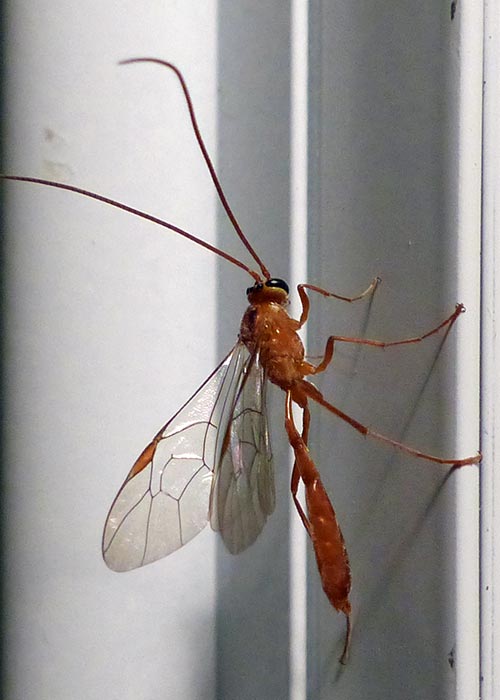
Ichneumons frequently have a white or yellow band on their long antennae. Their slender, often-curved abdomens may be “flattened.” They occupy a wide variety of habitats, and most are nocturnal and/or crepuscular (active at dawn or dusk) (from the Latin crepusculum meaning twilight).
Adults are nectarivores (that’s a real word), but their larvae are most assuredly not. Ichneumon comes from the Greek word for hunter or tracker. Females track down moth caterpillars, wasp or beetle larvae or pupae, or spiders to act as hosts and insert their eggs into them. Some target only one or two species. Most Ichneumon larvae are (vocabulary word alert) koinobiont parasitoids—that is, they keep their hosts alive as they feed either from the inside or the outside. They ultimately emerge from the host as adults, but the host does not survive the experience. Ichneumons are considered important biological controls of some pest insects. Despite their waspy appearance, they are eaten by predators, and their larvae are a bonus afflicted caterpillar is eaten.
Caveat emptor—Kaufman and Eaton, in their Field Guide to Insects of North America say “Think warblers are difficult? They are a cakewalk compared to identifying ichneumon wasps.” Bugguide.net tells us that “Ichneumonids are notoriously hard to identify: aside from the sheer number of species, there are numerous cases of distant relatives that appear almost identical. Any identification based solely on comparing images should be treated as suspect unless an expert has said there are no lookalikes for the species or group in question.” Once again, the BugLady is heading where angels fear to tread—she’s positive of the black and white Arotes, reasonably sure of the orange Exetastes and the Acroricnus, and the black Xorides is a “maybe.” None of the four has a common name.
Finally, lest anyone accuse the BugLady of brevity, there’s just not that much biographical information out there about most of these interesting critters.
Arotes amoenus
Arotes amoenus is in the subfamily Acaenitinae, a subfamily that is present on all of the continents except Antarctica, though it’s represented in South America by only one species. Acaenitinae are more diverse in northern climes, with fewer species in the southern U.S. Most of the species in the genus employ beetle grubs as larval hosts, along with some of the moth and wasp larvae that they find in wood.
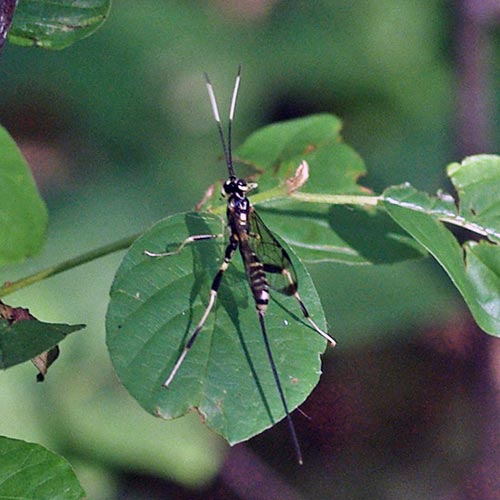
The handsome AA, a fairly common species, is found in the eastern half of North America; its primary host is a false darkling beetle named Melandrya striata whose adults live under loose bark and whose larvae tunnel in deciduous logs.
Exetastes angustoralis
Exetastes angustoralis is one of 1,500 species in the subfamily Banchinae (600 in North America), which specializes in moth larvae, with the larvae of some beetles and bees on the side. Females of some species of Banchinae have very long ovipositors that they can use to reach larvae that are hidden in vegetation or that live in wood.
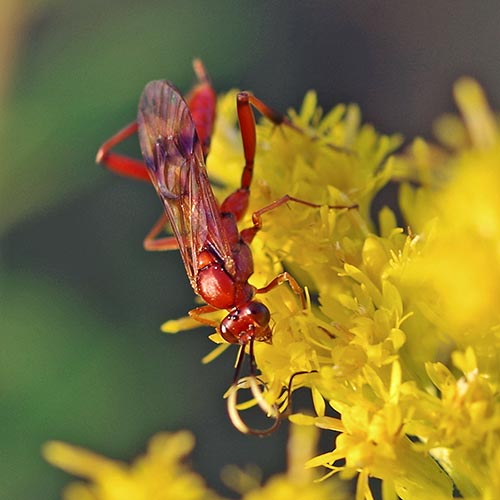
The EA lays its eggs on the larvae of the Dingy Cutworm Moth, of previous BOTW fame. Adults are active during the day, nectaring on goldenrod and asters. They are found over much of North America, mostly east of the Rockies, but not along the Gulf Coast and in the desert Southwest.
Xorides stigmapterous
Xorides stigmapterous (probably) belongs to the small subfamily Xoridinae (a quarter of its 200 species live in North America), a forest-loving group whose beetle hosts live in rotting wood. Larvae may develop on beetle grubs or pupae, or even on mature beetles that haven’t left their pupal case. Scientists suspect that the female stings and paralyzes her offspring’s chow before she oviposits. Like the Banchinae above, this is a group that has fewer species as you go south.
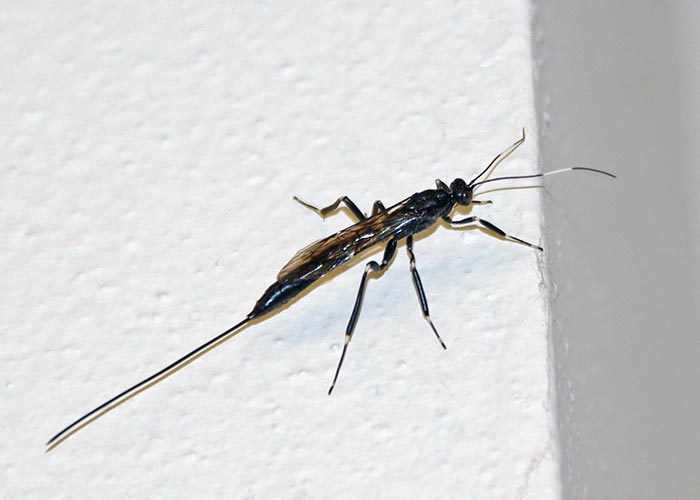
Kaufman and Eaton tell us to “look for females as they prospect for hosts on the surface of logs.” This they do by tapping their antennae on the bark as they walk around on the trunk, trying to pick up vibrations from active beetle grubs within. XS specializes in Long-horned beetles (Cerambycidae).
Acroricnus stylator
Acroricnus stylator is in the largest Ichneumon subfamily, Cryptinae, with 765 species north of the Rio Grande. They are external parasites of cocoons and pupal cases, chewing from the outside on the larvae of wood-boring beetles, some flies, and a few kinds of wasps (including some ichneumons). Cryptinae includes some wingless species that look very ant-like.
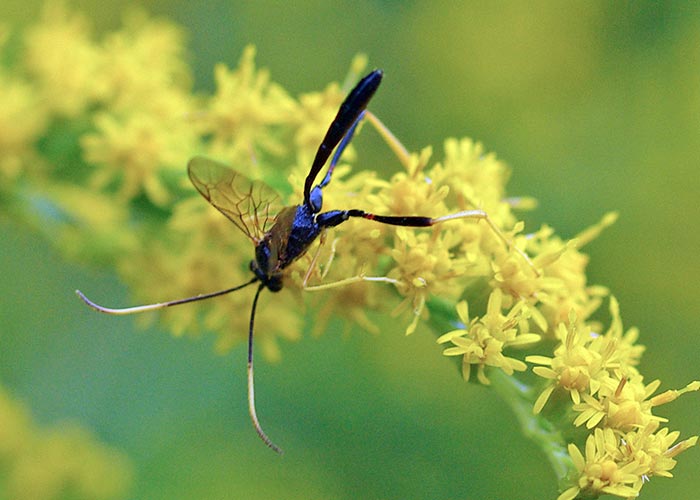
AS parasitizes some of the wasps that build egg chambers out of mud. Their range is listed as eastern North America, but there were many AS “hits” from British and western European sites, where the mason/potter wasps are listed as their hosts. Various subspecies have been described based on variation in coloring.
Summer is coming—go outside and scrutinize an Ichneumon!
The Bug Lady
P.S. Professor B. pointed out that the BugLady had neglected to include a link to the Grasshoppers of Wisconsin